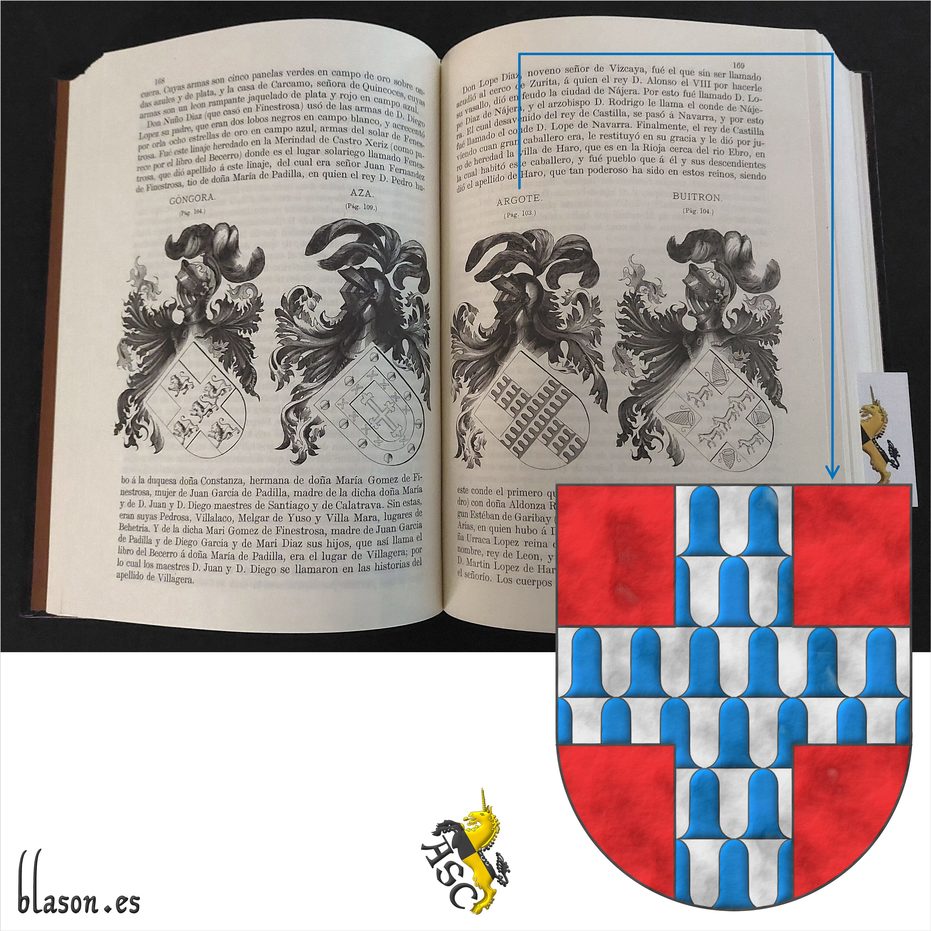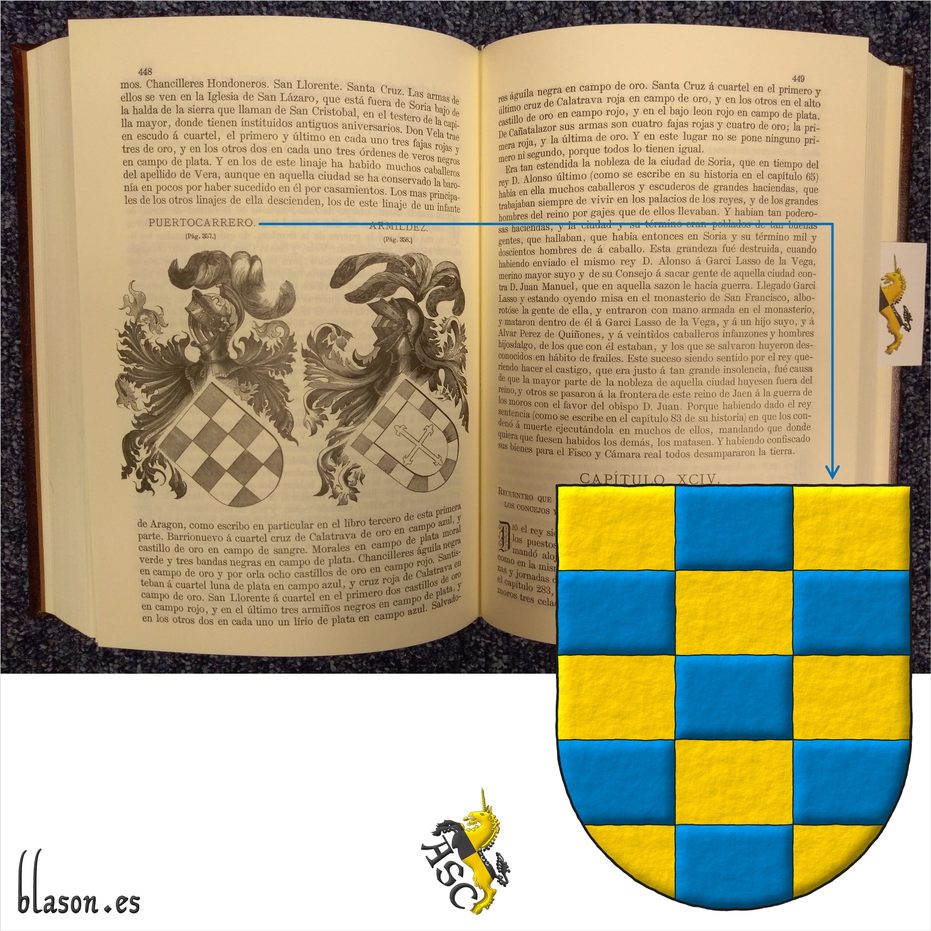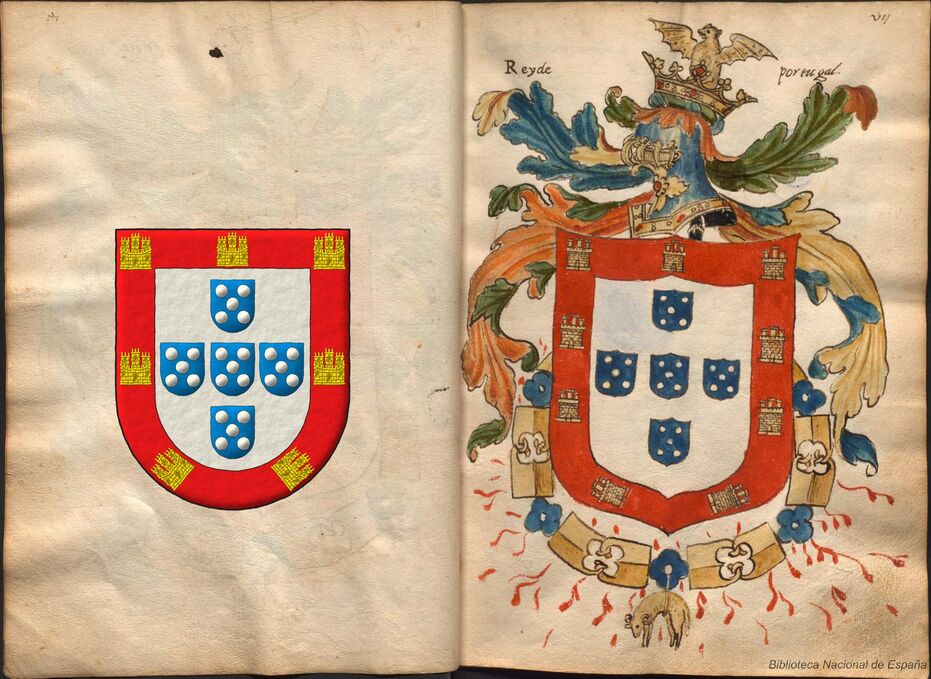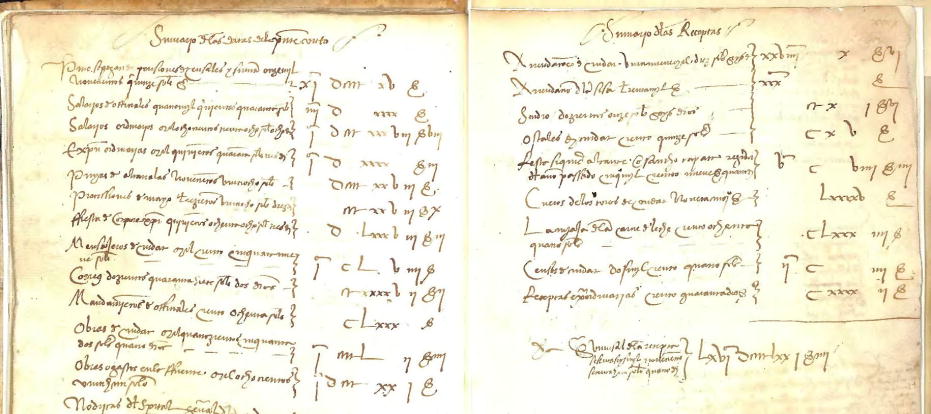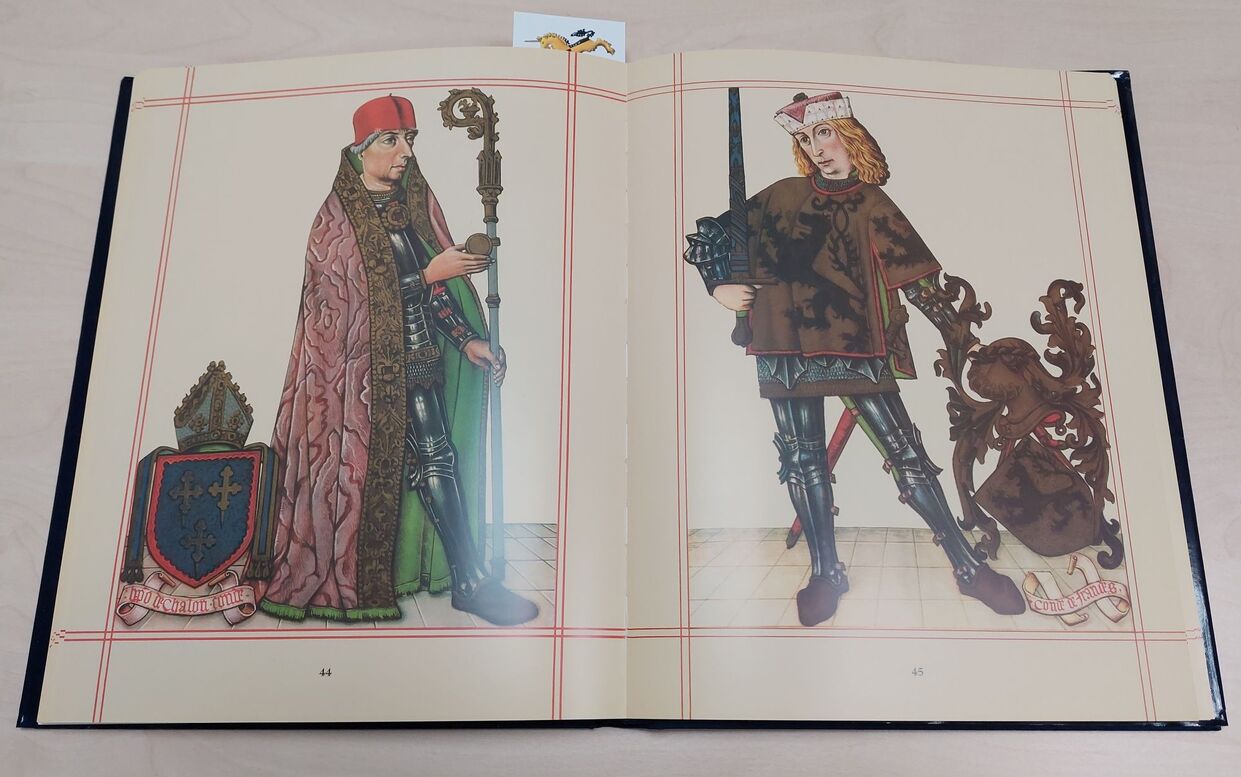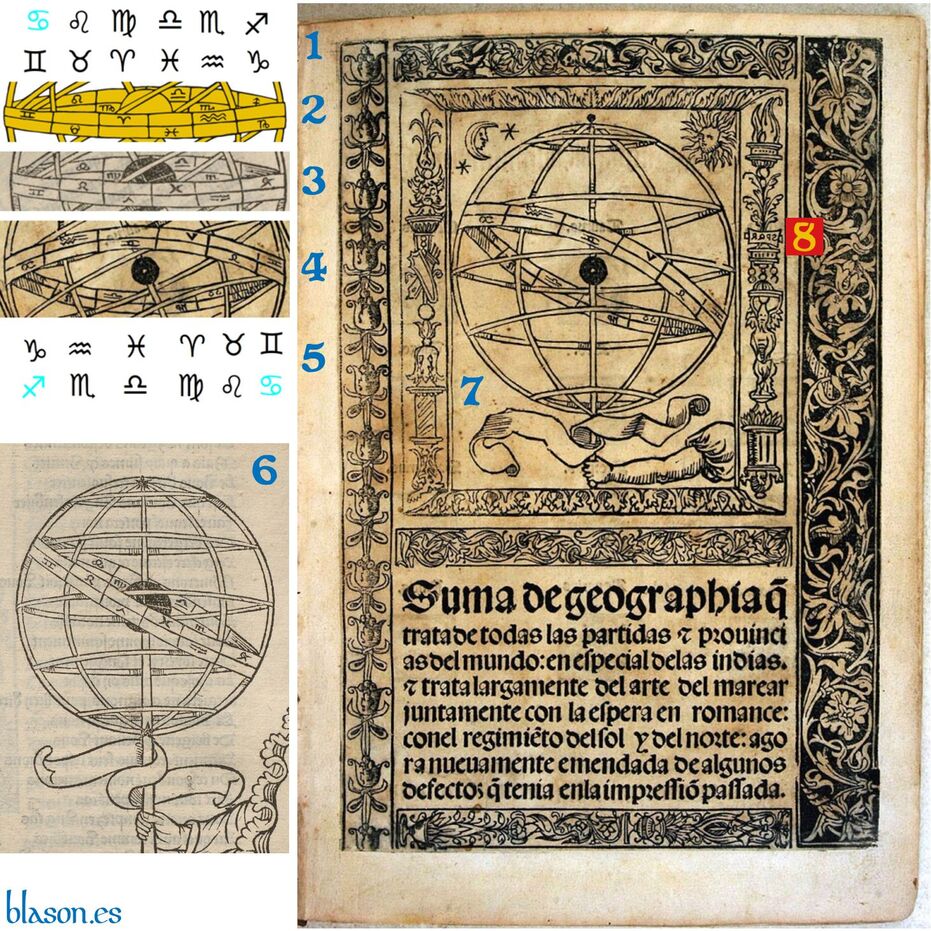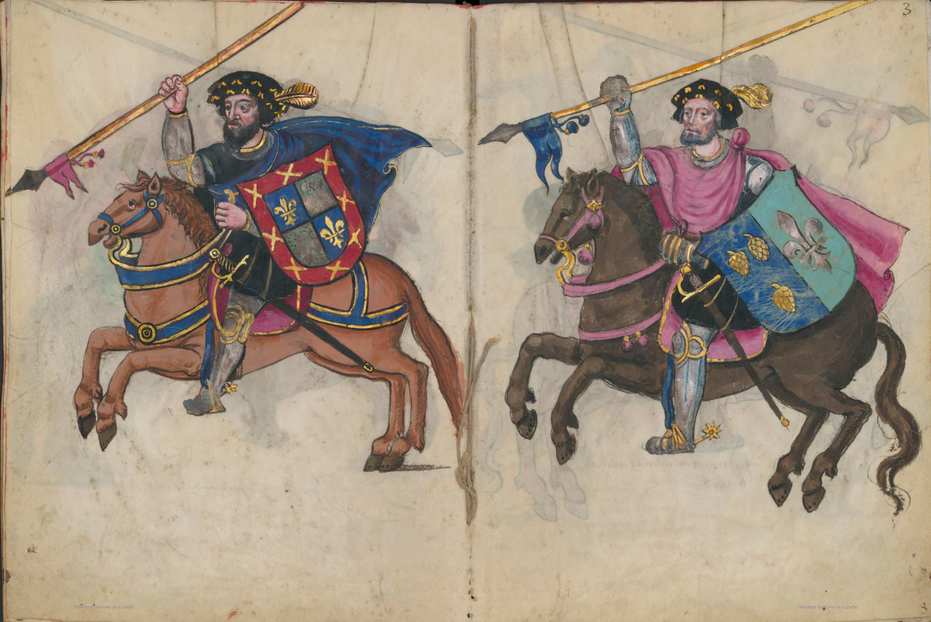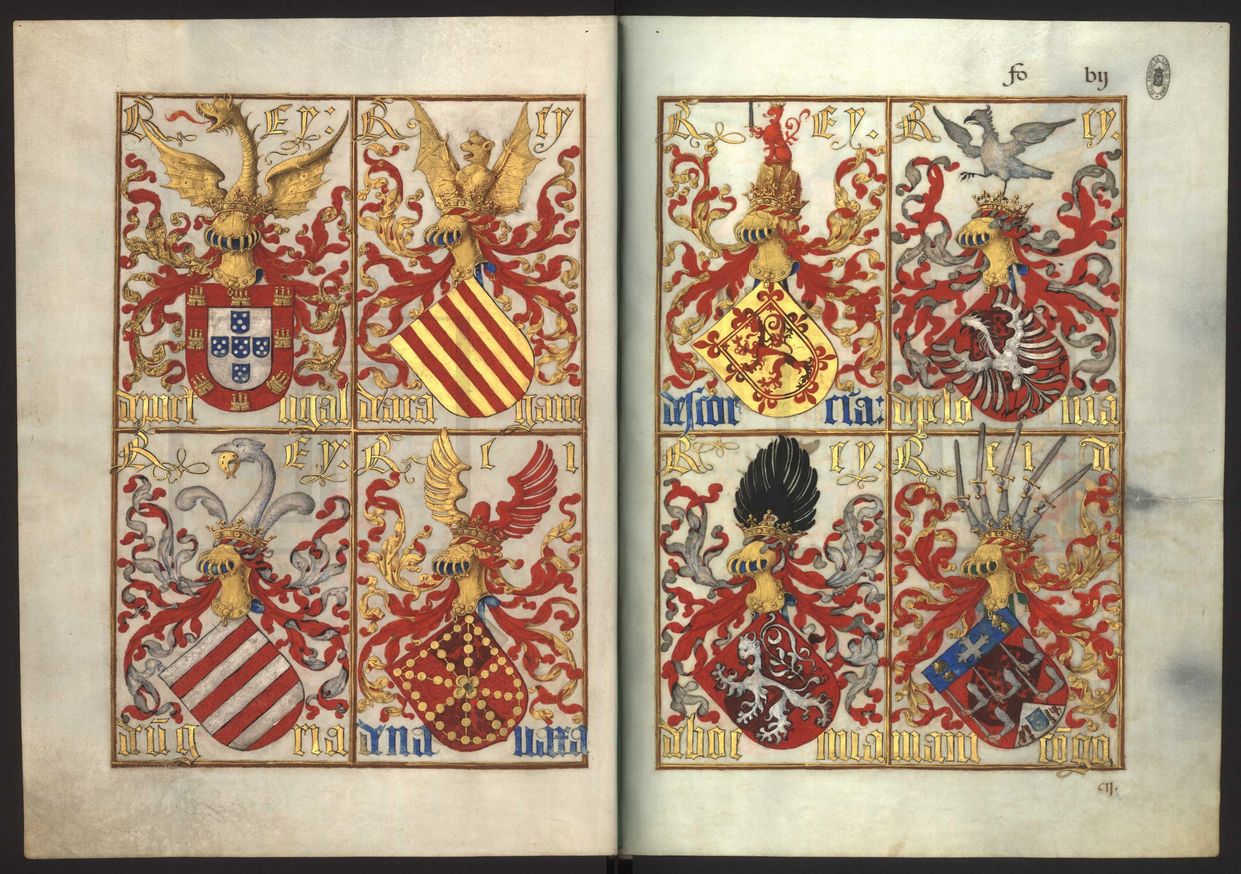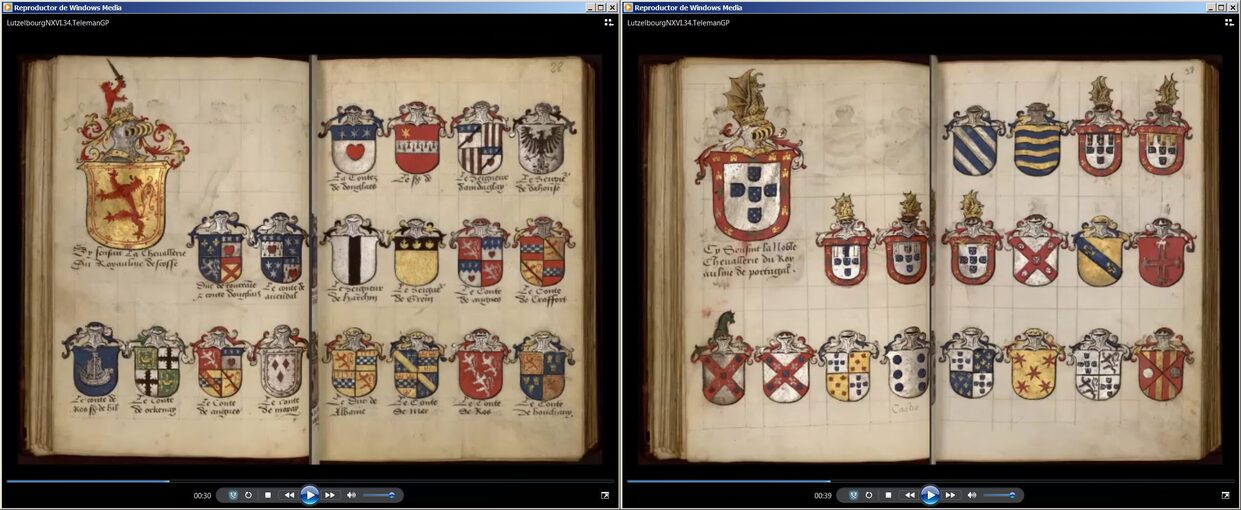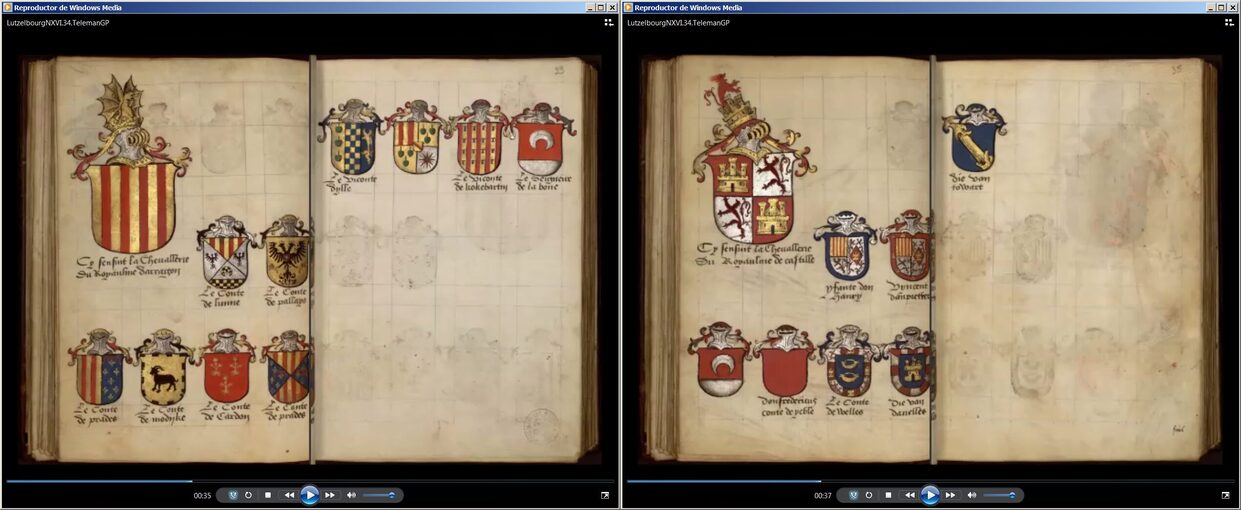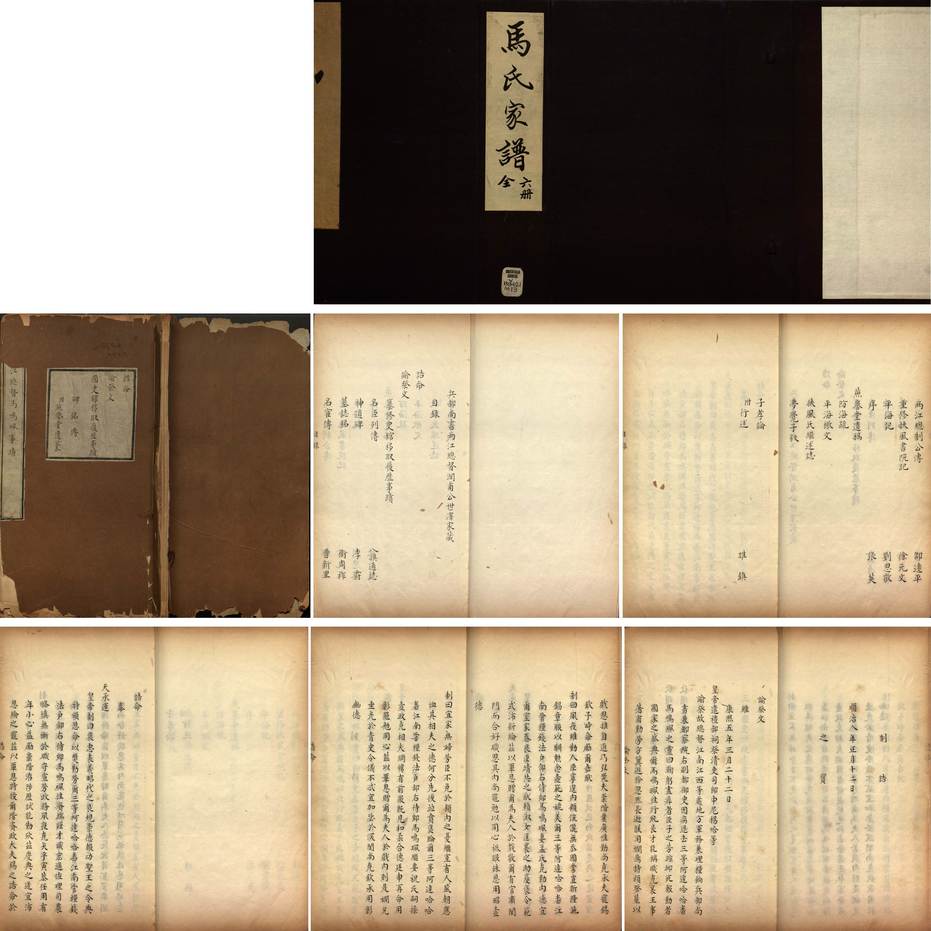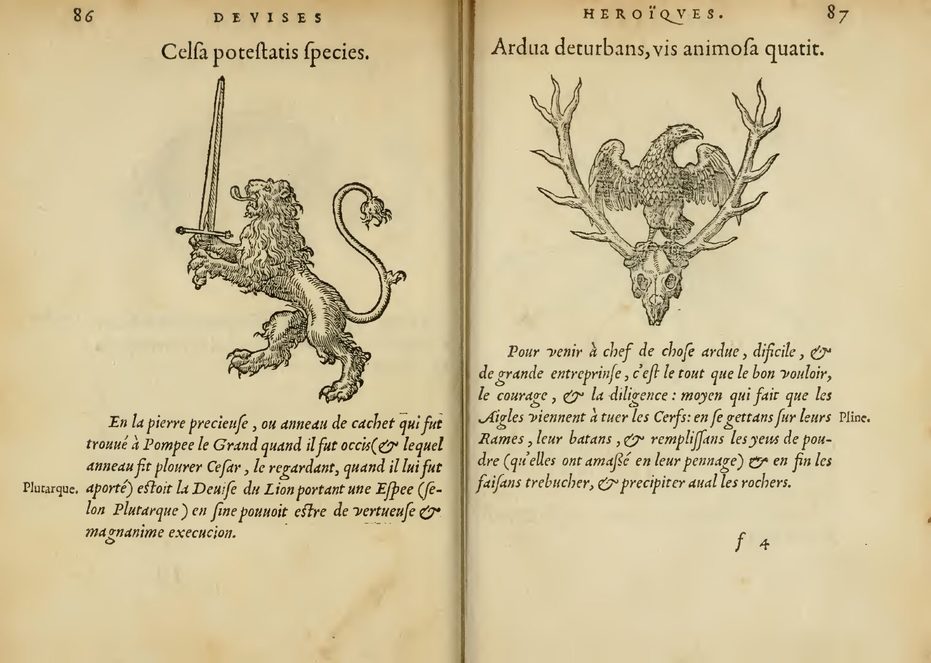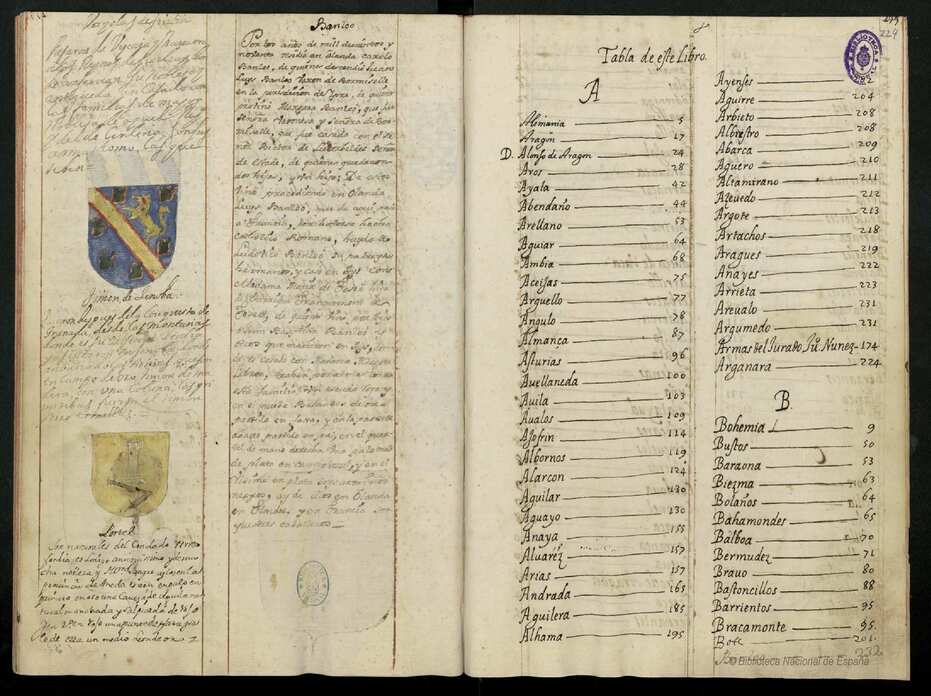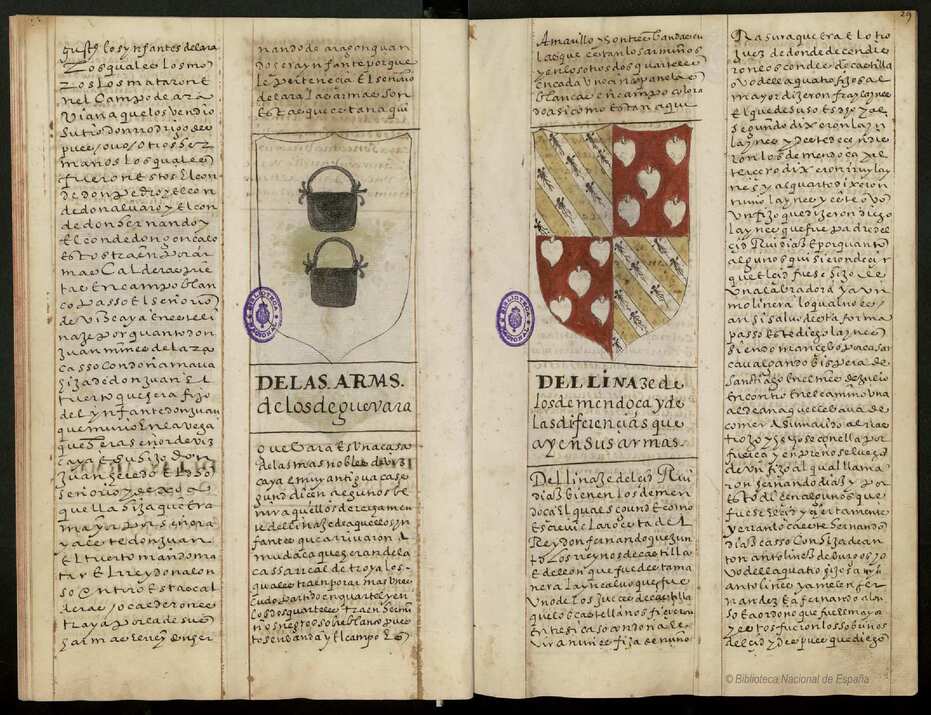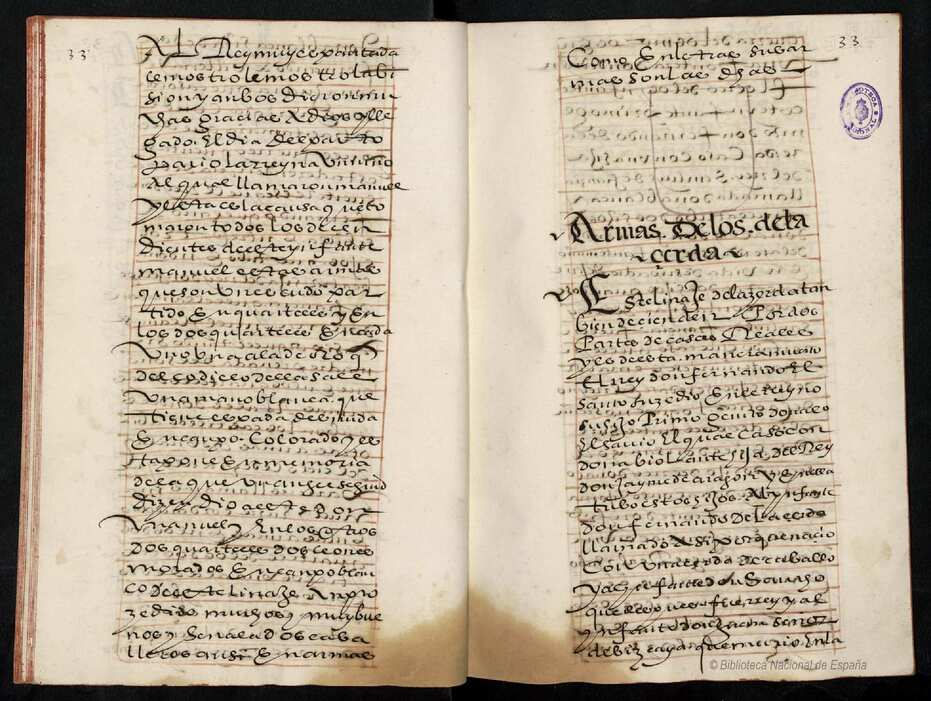Century XVI


![Ver [Argote de Molina, G.; 1588] en referencias bibliográficas. Libro abierto, hojas de plata, filo de oro, guardas de gules, tapas de sable.](../css/Libro.Bibliografia.png)
Argote de Molina, G.; 1588
Gonzalo Argote de Molina, «Nobleza de Andalucía», dedicated to King Philip II of Spain, with about 500 coat of arms engraved, printed by Fernando Díaz, Seville, 1588.
There are other editions, for example, the edition by Francisco López Vizcaíno, 799 pages, Jaen, 1867, or facsimile edition by Riquelme y Vargas Ediciones SL, Jaén, 1991, my copy is the number 1268.
Bibliographical reference of century XVI.
Classification: De bibliotheca, Castilian language and In black and white.
The author is Argote de Molina, Gonzalo.
The following articles cite this bibliographic reference:
- Alfonso IX of Leon
- Alfonso VIII of Castile
- Argote de Molina, Gonzalo
- James I of Aragon
- Álvaro de Zúñiga y Guzmán
External resources:
- Virtual Library of Andalusia, 1867.
- Digital Library Madrid's memory, 1588 edition from page 6 missing cover and initial pages.
- National Library of Spain, bibliographic record, there are 2 copies of the edición of 1588.
- National Library of Spain, edition of 1588, cover of the first copy.
- National Library of Spain, edition of 1588, cover of the second copy, this has more resolution than the previous copy.
- Google Books, the second book and not complete.
Internal resources: ArgoteMolinaG1588.22.NoblezaAndalucia.Madrid.pdf is the edition of the year 1588 in PDF digital format, ArgoteMolinaG1588.23.Bne.Baja.resolucion.R10805.pdf is the edition of the year 1588 in PDF digital format and low resolution, ArgoteMolinaG1588.24.Bne.Alta.resolucion.R26842.pdf is the edition of the year 1588 in PDF digital format and hight resolution, ArgoteMolinaG1588.25.NoblezaAndalucia.1867.pdf is the edition of the year 1866 in PDF digital format for Adobe Reader only and a facsimile edition as a physical book on paper.


![Ver [Avilés, T. de; XVI] en referencias bibliográficas. Libro abierto, hojas de plata, filo de oro, guardas de gules, tapas de sable.](../css/Libro.Bibliografia.png)
Avilés, T. de; XVI
Tirso de Avilés, continued by Martín de Bolea y Castro, «Roll of arms», 3 volumes, Volume I, coats of arms of kings, princes and grand titles, 208 hand-numbered pages in Roman numerals, Volume II, coats of arms of noble and private titles, 129 hand-numbered pages in Arabic numerals, Volume III, coats of arms of popes, cardinals, archbishops and bishops, 185 hand-numbered pages in Arabic numerals, in the National Library of Spain, signatures Mss/12550 V.1, Mss/12551 V.2 and Mss/12552 V.3, it is estimated from the XVI century.
Bibliographical reference of century XVI.
Classification: Manuscript, Armorial roll, In color and Castilian language.
The author is Avilés, Tirso de.
The following article cites this bibliographic reference:
External resources:
- Detail of this armorial in the National Library of Spain.
- Bibliographic record of the National Library of Spain.
- Scanned Armorial in the National Library of Spain.
Internal resources: Volume I AvilesTdeXVI.11.Tomo01.pdf, Volume II AvilesTdeXVI.11.Tomo02.pdf and Volume III AvilesTdeXVI.11.Tomo03.pdf.
Credits: This book belongs to the Biblioteca Nacional de España. License Creative Commons CC-BY. You may share, transform and create from images in the public domain that are accessible in the Hispanic Digital Library.


![Ver [Bosque, J. del; 1540] en referencias bibliográficas. Libro abierto, hojas de plata, filo de oro, guardas de gules, tapas de sable.](../css/Libro.Bibliografia.png)
Bosque, J. del; 1540
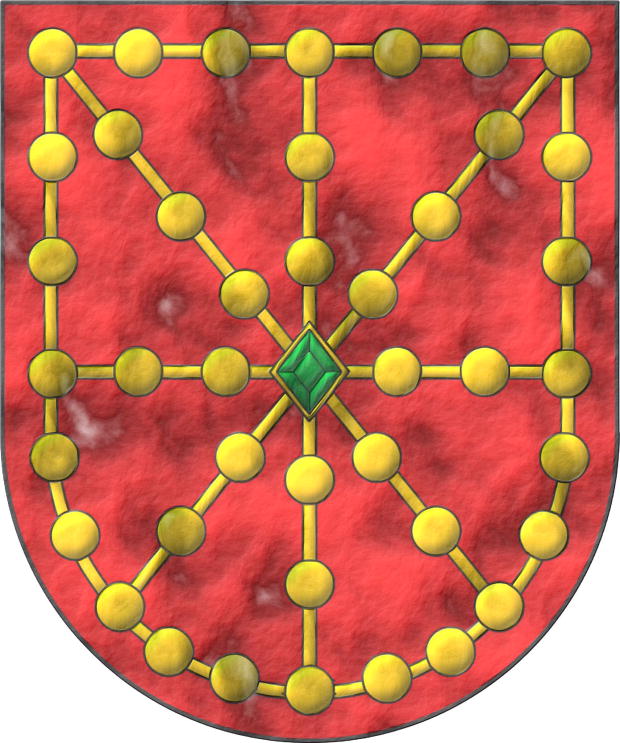
Juan del Bosque, «Libro de Armería del Reino de Navarra», which is currently missing and whose subsequent copy, commissioned in 1572, is kept in the Royal and General Archive of Navarre, estimated year of creation 1540.
The origin of this armorial dates back to 1527, when the Navarrese Courts requested that the Royal Council and the Chamber of Comptos ~ Chamber of Accounts and Fiscal Control, record in a book the coats of arms of the kingdom of Navarre starting with that of the king of Navarre and the houses and lineages of the so-called «ricoshombres», Almorrabides, Guebara, Aybar, Baztanes, Urroz, Lete, Subiça, Rada, Vidaurre, Qasqante, Monteagudo, and Mauleón, also including the coats of arms of other manors, houses, valleys, towns, and nobles [Valverde Ogallar, P. B.; 2001; page 326].
According to [Martinena Ruiz, J. J.; 1982; page 35] the book was compiled around the year 1540, and this is the date I use for referencing this armorial.
This first manuscript created by Juan del Bosque was taken by the royal visitor Hernán Suárez de Toledo, under the pretext of taking it to Emperor Charles V, despite being requested back by the Navarrese Courts, it was never returned and was definitively lost. The armorial that has come down to us is a recreation commissioned in 1572 [Valverde Ogallar, P. B.; 2001; page 327].
According to [Menéndez Pidal de Navascués, F.; 1974; page 19] the recreation of this armorial was carried out based on certifications, such as those from the herald Azcárraga, and notes and partial copies of the stolen book, like the copy kept in the monastery of Leyre.
Another noteworthy bibliographic reference about this armorial, in addition to those previously mentioned, is [Martinena Ruiz, J. J.; Menéndez Pidal de Navascués, F.; 2001].
The image illustrating this bibliographic reference is the coat of arms of the king of Navarre, which I recreated based on the illustration in this armorial, on its first folio according to the numbering given to it in 1613.
Bibliographical reference of century XVI.
The author is Bosque, Juan del.
Here are the articles quoting this reference:
- Almorrabides of Navarre
- Aybar of Navarre
- Baztanes of Navarre
- Guebara of Navarre
- Lete of Navarre
- Martinena Ruiz, J. J.; 1982
- Martinena Ruiz, J. J.; Menéndez Pidal de Navascués, F.; 2001
- Mauleón of Navarre
- Menéndez Pidal de Navascués, F.; 1974
- Menéndez Pidal de Navascués, F.; 1985
- Menéndez Pidal de Navascués, F.; Martínez de Aguirre, J.; 2000
- Monteagudo of Navarra
- Navarra, closed carbuncle
- Navarre
- Noblemen of Navarre
- Qasqante of Navarre
- Rada of Navarre
- Subiça of Navarre
- Urroz of Navarre
- Vidaurre of Navarre


![Ver [Calvo, P.; 1501] en referencias bibliográficas. Libro abierto, hojas de plata, filo de oro, guardas de gules, tapas de sable.](../css/Libro.Bibliografia.png)
Calvo, P.; 1501
Pedro Calvo, notary and alderman of the city of Calatayud, «Libro de cuentas de la ciudad de Calatayud» ~ «Account book of the city of Calatayud», literal title, «Libro dela data fecha por pedro calvo notao Regidor dela ciutat de Calatayut enel anyo de mil Quinientos y uno», manuscript restored with cover, back cover and Mudejar style binding, 2 blank pages behind the cover and the back cover, 76 inner pages of 300 x 230 mm, of which 7 could be in white and in even position, 3 in white among the first 20 pages, 1 blank towards the middle of the book and another 3 blank between the last 20 pages, final annotation with the term «cabreo», Calatayud, 1501.
Bibliographical reference of century XVI.
Classification: Manuscript, In black and white and Castilian language.
Author: Calvo, Pedro.
External resources:
- Documents and archives of Aragon, DARA Medieval, registry of the book and link to the image included here.
- Name of the Latin written after the fall of the Roman Empire and during the Middle Ages.
Internal resources: CalvoP1501.CalatayudDataOriginal.pdf book as a sequence of available pages and CalvoP1501.CalatayudDataPaginado.pdf book recomposed in sequence of odd and even pages, with blank pages inserted to recover lost sequences.


![Ver [Cró, J. do; 1509] en referencias bibliográficas. Libro abierto, hojas de plata, filo de oro, guardas de gules, tapas de sable.](../css/Libro.Bibliografia.png)
Cró, J. do; 1509
João do Cró, «Livro do Armeiro-Mor», roll of arms manuscript, written and emblazoned during the reign of Manuel I of Portugal, 161 pages, it is in the Torre do Tombo National Archive, ca 1509.
Bibliographical reference of century XVI.
Classification: Manuscript, Armorial roll, In color and Portuguese language.
Author: João do Cró.
Bibliographic reference mentioned in the following articles:
External resource:
Internal resources: CroJdo1509.LivroDoArmeiroMor.02.Comentado.Desordenado.pdf 277 pages and Facsimile edition on paper.


![Ver [Fernández de Enciso, M.; 1519] en referencias bibliográficas. Libro abierto, hojas de plata, filo de oro, guardas de gules, tapas de sable.](../css/Libro.Bibliografia.png)
Fernández de Enciso, M.; 1519
Martin Fernandez de Enciso, «Sum of Geography, which deals with all the parts and provinces of the world: especially the Indies. And deals extensively with the art of navigation, together with the sphere in the vernacular, with the regulation of the Sun and the North: newly made. With royal privilege.», 148 pages, House of Trade (Casa de la Contratación), Seville, 1519.
Preliminary note
Note that I try to use, even in these non-heraldic cases, the language of blazon, thus I speak of positions such as in chief, in base, dexter or sinister, arrangements such as in bend and in bend sinister and tinctures such as sable, azure or gules.
Zodiacal bands in armillary spheres: A comparative analysis of Marchant (1499) and Fernández de Enciso (1519) engravings
[Marchant, G.; 1499; page 15] and [Fernández de Enciso, M.; 1519; page 1] depict an armillary sphere with the zodiac signs, &Aries; Aries, &Taurus; Taurus, &Gemini; Gemini, &Cancer; Cancer, &Leo; Leo, &Virgo; Virgo, &Libra; Libra, &Scorpio; Scorpio, &Sagittarius; Sagittarius, &Capricorn; Capricorn, &Aquarius; Aquarius and &Pisces; Pisces, represented on a band around the sphere. I have compared both zodiacal bands by means of the composition of the previous image.
In this image I have made there are:
- In the 3rd row, the band of zodiac signs of the armillary sphere by [Marchant, G.; 1499].
- Above, in the 2nd row, the band of my interpretation of the same previous engraving.
- In chief, at the very top, in the 1st row, the zodiac signs in sable and azure, with those not visible, in the order of [Marchant, G.; 1499], that is, as read by the reader of the book, from his frontal perspective of the engraving, in counterclockwise direction, &Gemini;, &Taurus;, &Aries;, &Pisces;, &Aquarius;, &Capricorn;, &Sagittarius;, &Scorpio;, &Libra;, &Virgo;, &Leo; and &Cancer; which is not visible. Note that, for example, Taurus appears before Aries so the sequence is geocentric, that is, arranged from the point of view of an observer located at the center of the Earth, which is different from the book reader.
- Below, in the 4th row, the band of zodiac signs of the armillary sphere by [Fernández de Enciso, M.; 1519].
- In base, at the very bottom, in the 5th row, the zodiac signs in black and in cyan, with those not visible, in the order of [Fernández de Enciso, M.; 1519], that is, as read by the same reader of the book in counterclockwise direction, &Capricorn;, &Aquarius;, &Pisces;, &Aries;, &Taurus;, &Gemini;, &Cancer; which is not visible, &Leo;, &Virgo;, &Libra;, &Scorpio;, and &Sagittarius; which is also not visible. Note that in this case, for example, Aries appears before Taurus so the sequence is ecliptic, that is, from the point of view of an observer located in outer space, the point of view of the ecliptic sequence coinciding with the point of view of the book reader.
The 3 main differences observed are:
- [Marchant, G.; 1499], number 6 in the image, places at the top the zodiac signs that [Fernández de Enciso, M.; 1519], number 7 in the image, places at the bottom, as a curiosity it can be seen in my interpretation of [Marchant, G.; 1499] that for aesthetic reasons I placed at top and bottom the zodiac signs as [Fernández de Enciso, M.; 1519] does.
- They do not start in the same position, it is &Aries; Aries that has a more similar position in both but with one slot of difference.
- The signs in [Marchant, G.; 1499] and [Fernández de Enciso, M.; 1519] rotate in opposite directions.
The only important conceptual difference is the reverse rotation of the zodiac signs, that is, that [Marchant, G.; 1499] uses the geocentric sequence and [Fernández de Enciso, M.; 1519] uses the ecliptic sequence. In no case is it a printing error of an engraving in mirror, since neither of the two armillary spheres is engraved in mirror, as both have the zodiacal band in bend, and if they were engraved in mirror the zodiacal band would appear placed in bend sinister.
We could also study the few non-symmetrical signs that can be distinguished completely:
- For example, on the back side of the band of [Marchant, G.; 1499], &Scorpio; Scorpio has the scorpion’s stinger in the shape of an m pointing to sinister (the reader’s right), so it makes sense from the point of view of a geocentric observer.
- For example, on the back side of the band of [Fernández de Enciso, M.; 1519], &Leo; Leo seems to have the circle of its head to dexter (the reader’s left) and the curl of its tail to sinister (the left of a geocentric observer), while in &Scorpio; Scorpio, the stinger of the m-scorpion seems to point to dexter (the reader’s left) as if the sign were intended to be seen from the other side of the outside, piercing the band, so that the book reader sees the sign in mirror. Be that as it may, the arrangement of these 2 signs does not seem consistent with each other.
Although it is not a case of printing the engraving in mirror, such errors exist since, if we go beyond the armillary sphere of [Fernández de Enciso, M.; 1519] to study its outer decoration, we see that the SPQR, of «Senatus Populusque Romanus», is in mirror, I have marked it with a square of gules with the number 8 in the image, so that, although its armillary sphere is well printed, in the outer decoration the printer made a mistake and printed it the other way round.
Bibliographical reference of century XVI.
Classification: In black and white and Castilian language.
Author: Fernández de Enciso, Martín.
The following articles cite this bibliographic reference:
External links:
Internal resources: FernandezDeEncisoM1519.SumaDeGeographia.CatedraNaval.pdf in scanned PDF format at the Naval Chair, Spanish Navy, University of Murcia..


![Ver [Gamonal; Century XVI] en referencias bibliográficas. Libro abierto, hojas de plata, filo de oro, guardas de gules, tapas de sable.](../css/Libro.Bibliografia.png)
Gamonal; Century XVI
Anonymous, «Libro en que se pintan los cavalleros cofrades de la Cofradía de Nuestra Señora de Gamonal», National Library of Spain, call number Mss/22258, manuscript, illustrated, 4+((28-3)*2+1)+2 = 57 pages, 27 folios, 30 x 23 centimeters, Burgos, 1575-1600.
Content and notes
This manuscript contains 46 full-page, mannerist-style portraits of equestrian knights, members of the Cofradía de Nuestra Señora de Gamonal, with their coats of arms, painted in color and illuminated with gold and silver, though some remain unfinished. Below some of the images, the name of the knight is inscribed. An annotation on the cover reads: «Jusepe de Aiala pintose en [B]urgos» indicating the possible artist. The manuscript has been foliated in ink at the lower right corner and in pencil at the upper right, modernized. Some notes in 19th-century handwriting are also present.
Bibliographical reference of century XVI.
Classification: Manuscript, Armorial roll, Castilian language and In color.
The author is unknown.
External resource:
Internal resources: GamonalXVI.Armorial.Ecuestre.pdf PDF format.


![Ver [Godinho, A.; 1521] en referencias bibliográficas. Libro abierto, hojas de plata, filo de oro, guardas de gules, tapas de sable.](../css/Libro.Bibliografia.png)
Godinho, A.; 1521
António Godinho, «Livro da nobreza e da perfeição das armas dos reis cristãos e nobres linhagens dos reinos e senhorios de Portugal» ~ «Book of Nobility and Perfection of the Arms of Christian Kings and Noble Lineages of the Kingdoms and Lordships of Portugal», 1 book, parchment, 66 pages, 4 coats of arms per page, 43 x 32 centimeters, ca. 1521.
António Godinho was a clerk of the Chamber of King John III, but the codex was started during the time of King Manuel (ca. 13 December 1521). I use the year 1521 only for the purpose of creating the book key.
I think the book contains 263 illuminated coats of arms, including those of the King of Portugal, the King of Castile, the King of Aragon, and others. It was restored and returned to the archive on the 21st of June, 1904.
Bibliographical reference of century XVI.
Classification: Manuscript and Armorial roll.
The author is Godinho, António.


![Ver [Lutzelbourg, N. de; 1530] en referencias bibliográficas. Libro abierto, hojas de plata, filo de oro, guardas de gules, tapas de sable.](../css/Libro.Bibliografia.png)
Lutzelbourg, N. de; 1530
Nicolas de Lutzelbourg, lord of Fléville and captain of Nancy, «Roll of arms», sixteenth century (the author lived between 1485? and 1547), manuscript in French on parchment, with 230 pages numbered later with pencil the odd pages from 1 to 115, 29 x 21 cm, Bibliothèque-Médiathèque of Nancy digitized, source of the images with open license.
Video of 120 seconds composed for the Biblioteca Genealógica, Heráldica y Nobiliaria. Music by Georg Philipp Telemann (1681, 1767), Concerto for 4 Violins No. 2, TWV 40: 202, II. Grave, interpreted by Viola Viva, with Creative Commons license of Attribution and ShareAlike.
Content examples: Scotland on pages 28, 29 and 30 with 61 coat of arms; Aragon on page 33 with 11 coat of arms; Castile and Leon on page 35 with 8 coat of arms; Navarre on page 36 with 1 coat of arms; and Portugal on pages 37 and 38 with 27 coat of arms.
Bibliographical reference of century XVI.
Classification: Manuscript, Armorial roll, French language and In color.
The author is Lutzelbourg, Nicolas de.
Here are the articles quoting this reference:
External links:
- Manuscript's record in the Bibliothèque-Médiathèque of Nancy.
- Manuscript's pages in the Bibliothèque-Médiathèque of Nancy.


![Ver [Ma, F.; Century XVI] en referencias bibliográficas. Libro abierto, hojas de plata, filo de oro, guardas de gules, tapas de sable.](../css/Libro.Bibliografia.png)
Ma, F.; Century XVI
Anonymous, «Genealogy of the Mǎ Family, 馬民家记», manuscript, from the late Ming to early Qing dynasty, 6 volumes, volume 1, 102 pages, volume 2, 304 pages, volume 3, 242 pages, volume 4, 202 pages, volume 5, 100 pages, and volume 6, 178 pages, total 1128 pages, dated between 1600 and 1735, circa 1735.
Disclaimer
These comments has been writen based on my limited knowledge of Classical Chinese. As such, it may contain inaccuracies or errors. I apologize for any errors and welcome corrections from those more knowledgeable in the subject. It is important to note that, although the manuscript is written in Classical Chinese, some characters in theses comments are in Simplified Chinese.
Cover
-
The title of the work on the cover is
«馬民家记», where:
- «民家记» means Genealogy, and
- «馬» is Mǎ in pīnyīn, it is the family name, literally meaning Horse.
-
The character «馬» is an ideogram, representing a galloping horse:
- the head faces left,
- three horizontal lines to the right of the head represent the mane blowing in the wind,
- the four vertical strokes below represent the legs, and
- the curved stroke at the bottom right symbolizes the tail.
-
Beneath the title on the cover,
we read, from top to bottom and right to left,
as is typical in traditional Chinese:
«六写全» where:
- «六» means six,
- «写» means book, it hasn't plural, books for us, and
- «全» can be translated as complete.
Four generations
The title might suggest it is just the family tree of the Mǎ family, but it is actually a chronicle of the history of a lineage over four generations. Therefore, although it is dated between 1600 and 1735, it is likely written closer to 1735.
The manuscript narrates the deeds and actions of four generations of the Mǎ family from the city of Liáoyáng in northeastern China:
- Great-grandfather: Mǎ Mingpei (1600–1666),
- Grandfather: Mǎ Xiongzhen (1634–1677),
- Father: Mǎ Shiji (1650–1714),
- Son: Mǎ Guozhen (1666–1720).
It seems to be a story of ascent and descent:
- The great-grandfather was a significant figure.
- The grandfather was even more prominent, eventually assassinated, and posthumously awarded titles and an honorary name, «Wenyi».
- The father and son, though important, did not reach the heights of their predecessors.
This manuscript contains official titles, title grants, imperial praises for their actions, historical events, and also the poetic and literary works of the four generations.
Scanned for readability by Westerners
The correspondence between these 6 volumes and the 9 scaned PDF files is as follows:
- Volume 1: PDF 1.
- Volume 2: PDF 2 and PDF 3.
- Volume 3: PDF 4 and PDF 5.
- Volume 4: PDF 6 and PDF 7.
- Volume 5: PDF 8.
- Volume 6: PDF 9.
The Chinese books are read: from back to front, from right to left, and from top to bottom.
The scanning process was done so that what would be the last pages of the book for us, and the first for the Chinese, are at the beginning of the PDF. The pages are scanned in pairs to be readable by Westerners: starting from page 2-1, read from right to left, with 1 blank, and continuing 4-3, 6-5, 8-9... until the end of the PDF file.
The Chinese script used in this manuscript is clear and legible compared to other documents from that era.
Pages
6 volumes:
- volume 1, 51*2 = 102 pages,
- volume 2, 65*2+87*2 = 304 pages,
- volume 3, 66*2+55*2 = 242 pages,
- volume 4, 48*2+53*2 = 202 pages,
- volume 5, 50*2 = 100 pages, and
- volume 6, 89*2 = 178 pages,
Bibliographical reference of century XVI.
Classification: Manuscript, Classical Chinese language and In black and white.
Author: unknown.
External resources:
- Library of the Congress.
- Volume 2, initial part.
- Volume 2, final part.
- Volume 3, initial part.
- Volume 3, final part.
- Volume 4, initial part.
- Volume 4, final part.
- Volume 5.
- Volume 6.
Internal resources: MaFamiliaXVIII.01a.tapas.pdf Volume 1 PDF format, MaFamiliaXVIII.02a.tapas.pdf Volume 2, initial part, PDF format, MaFamiliaXVIII.02b.pdf Volume 2, final part, PDF format, MaFamiliaXVIII.03a.tapas.pdf Volume 3, initial part, PDF format, MaFamiliaXVIII.03b.pdf Volume 3, final part, PDF format, MaFamiliaXVIII.04a.tapas.pdf Volume 4, initial part, PDF format, MaFamiliaXVIII.04b.pdf Volume 4, final part, PDF format, MaFamiliaXVIII.05a.tapas.pdf Volume 5 PDF format and MaFamiliaXVIII.06a.tapas.pdf Volume 6 PDF format.
Bibliographical reference of century XVI.
Classification: Manuscript, Classical Chinese language and In black and white.
Author: unknown.
External resources:
- Library of the Congress.
- Volume 2, initial part.
- Volume 2, final part.
- Volume 3, initial part.
- Volume 3, final part.
- Volume 4, initial part.
- Volume 4, final part.
- Volume 5.
- Volume 6.
Internal resources: MaFamiliaXVIII.01a.tapas.pdf Volume 1 PDF format, MaFamiliaXVIII.02a.tapas.pdf Volume 2, initial part, PDF format, MaFamiliaXVIII.02b.pdf Volume 2, final part, PDF format, MaFamiliaXVIII.03a.tapas.pdf Volume 3, initial part, PDF format, MaFamiliaXVIII.03b.pdf Volume 3, final part, PDF format, MaFamiliaXVIII.04a.tapas.pdf Volume 4, initial part, PDF format, MaFamiliaXVIII.04b.pdf Volume 4, final part, PDF format, MaFamiliaXVIII.05a.tapas.pdf Volume 5 PDF format and MaFamiliaXVIII.06a.tapas.pdf Volume 6 PDF format.

![Ver [Paradin, C.; 1557] en referencias bibliográficas. Libro abierto, hojas de plata, filo de oro, guardas de gules, tapas de sable.](../css/Libro.Bibliografia.png)
Paradin, C.; 1557
Claude Paradin, «Devises heroïqves», with woodcuts attributed to Bernard Salomon, published by Jean de Tournes and Guillaume Gazeau, second edition, first edition published in 1551, dedication dated January 15, 1556, 261 pages, Lyon, 1557.
Description
The book includes emblems that consist of a motto, mostly in Latin, with a few in French or Greek, a woodcut illustration, and an explanation in French. The emblems feature devices of kings and rulers, symbols from the Bible, classical history, and other sources.
The title page is framed within a grotesque ornamental border. The copy includes the signature of C.F. Lüdorf, handwritten, on the lower left corner of the title page verso. There is irregular pagination with misprinted page numbers, foxing, and narrow margins. The book does not include a table of contents.
Examples of the first mottos
- Nullis praefentior aether, page 7.
- Manet insontem grauis exitus, page 9.
- Secum seret omina mords, page 11.
- Hîc ratio tentandi aditus, page 12.
- Pignora cara sui, page 13.
- Animis illabere nostris, page 14.
- Fortuna fidem mutata nouauir, page 15.
- Nutrisco & extinguo, page 16.
- Monstrant Regibus astra viam, page 18.
- Donec totum impleat orbem, page 20.
- Immensi tremor Oceani, page 22.
- Vlcus auos Troix, page 25.
- Non sine causa, page 27.
- Plus outre, page 29.
- Imperium sine fine dedi, page 32.
- Inextricabilis error, page 34.
- Securitas altera, page 36.
- Dederit'ne viam casus'ue Deus'ue, page 38.
- Fortitudo eius Rhodum tenuit, page 39.
- Non inferiora secutus, page 41.
- Ance ferit, quam flamma micet, page 43.
- Precium non vile laborum, page 44.
Bibliographical reference of century XVI.
Classification: Symbolism, In black and white and French language.
Author: Paradin, Claude.
External link:
Internal resources: ParadinC1557.DevisesHeroiqves.pdf PDF format.


![Ver [Pérez de Vargas, J.; XVI] en referencias bibliográficas. Libro abierto, hojas de plata, filo de oro, guardas de gules, tapas de sable.](../css/Libro.Bibliografia.png)
Pérez de Vargas, J.; XVI
Juan Pérez de Vargas, «Nobiliario», 228 pages with 2 columns, index between pages 224 and 228 ordered by initial but unordered within each initial, 31 x 23 centímeters, kept in the National Library of Spain, signature Mss/3061, it is estimated from the XVI century.
Structure
It follows a fixed structure for each entry: the name of the lineage or person, a horizontal line of separation, a explanatory text, a horizontal line of separation, coat of arms with the with of the column and full-color, a horizontal final line. All of this within the columns, only coming out for some exterior decorations, which I especially like.
My collaboration with the National Library of Spain
I have collaborated with the Department of Manuscripts, Incunabula, and Rare Books of the National Library of Spain to correctly attribute the authorship of this 16th century manuscript armorial titled «Nobiliario», signature Mss/3061, to Juan Pérez de Vargas. It has been quite an honor.
Bibliographical reference of century XVI.
Classification: Manuscript, Armorial roll, In color and Castilian language.
The author is Pérez de Vargas, Juan.
External resources:
- Detail of this armorial in the National Library of Spain.
- Bibliographic record of the National Library of Spain.
- Scanned Armorial in the National Library of Spain.
Internal resources: Pages from 1 to 117 PerezDeVargasJXVI.11.Paginas.001.117.pdf and Pages from 118 to 235 PerezDeVargasJXVI.12.Paginas.118.235.pdf.
Credits: This book belongs to the Biblioteca Nacional de España. License Creative Commons CC-BY. You may share, transform and create from images in the public domain that are accessible in the Hispanic Digital Library.


![Ver [Portolés, J.; Molino, M. del; 1590] en referencias bibliográficas. Libro abierto, hojas de plata, filo de oro, guardas de gules, tapas de sable.](../css/Libro.Bibliografia.png)
Portolés, J.; Molino, M. del; 1590
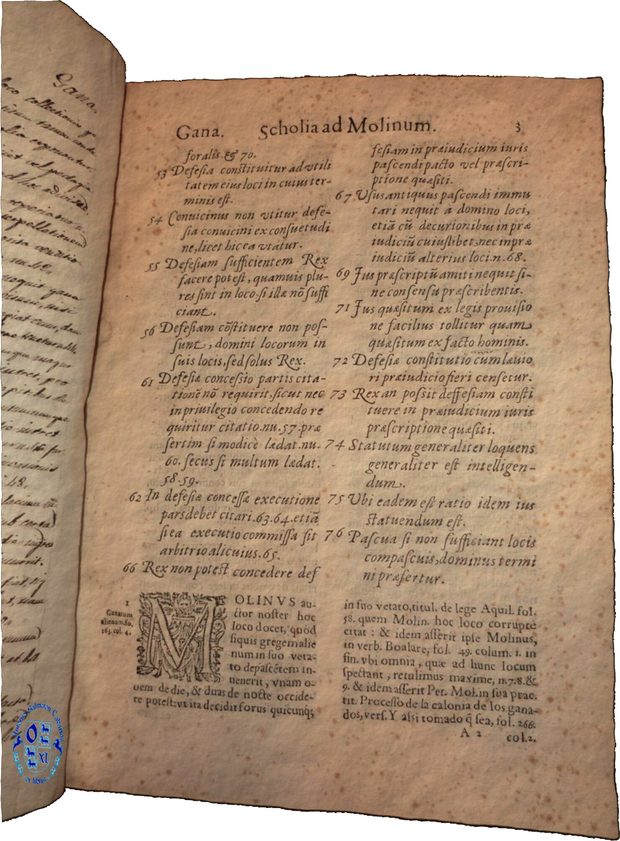
Jerónimo Portolés and Miguel del Molino, Ad Illustrisimos D. D. pradicti Regni Dipputatos, «Scholiorum Sive Adnotationum ad Repertorium Michaelis Molini Super Foris et Observantiis Regni Arago», Tertia pars, Cum Licentia Superiorum, Casaraugustae, per Laurentium de Robles, Regni Aragonum, et Universitatis Typographum, Zaragoza, 1590.
Foral law, history and charters of the Kingdom of Aragon.
Bibliographical reference of century XVI.
The 2 authors are Portolés, Jerónimo and Molino, Miguel del.
Bibliographical reference mentioned in the following article:
External link:


![Ver [Raber, V.; 1548] en referencias bibliográficas. Libro abierto, hojas de plata, filo de oro, guardas de gules, tapas de sable.](../css/Libro.Bibliografia.png)
Raber, V.; 1548
Vigil Raber, «Armorial con 7244 escudos de armas», 903 pages of content, almost all color pages, 7244 coat of arms, 30 x 21 centimeters, at the Herzogin Anna Amalia Library, shelf code Fol 220, permanent identifier 1249054540, 1548.
Bibliographical reference of century XVI.
Classification: Armorial roll, Manuscript, In color and German language.
Author: Raber, Vigil.
External resources:
- Record in the Herzogin Anna Amalia Library.
- Content in the Herzogin Anna Amalia Library.
- Content in the Bilder Server.


![Ver [Rodríguez de la Vega, A.; XVI] en referencias bibliográficas. Libro abierto, hojas de plata, filo de oro, guardas de gules, tapas de sable.](../css/Libro.Bibliografia.png)
Rodríguez de la Vega, A.; XVI
Alonso Rodríguez de la Vega, «Roll of arms of Spain», 377 hand-numbered pages in Arabic numerals, all coat of arms illustrations are only partially outlined and without tinctures, written according to the title page in the time of Emperor Charles V, in the National Library of Spain, signatures Mss/3330, it is estimated from the XVI century.
Bibliographical reference of century XVI.
Classification: Manuscript, Armorial roll, In black and white and Castilian language.
The author is Rodríguez de la Vega, Alonso.
External resources:
- Detail of this armorial in the National Library of Spain.
- Bibliographic record of the National Library of Spain.
- Scanned Armorial in the National Library of Spain.
Internal resources: RodriguezDeLaVegaAXVI.11.Paginas.001.129, RodriguezDeLaVegaAXVI.12.Paginas.130.258.pdf and RodriguezDeLaVegaAXVI.13.Paginas.259.387.pdf.
Credits: This book belongs to the Biblioteca Nacional de España. License Creative Commons CC-BY. You may share, transform and create from images in the public domain that are accessible in the Hispanic Digital Library.


![Ver [Rodríguez de Lena, P.; Century XVI] en referencias bibliográficas. Libro abierto, hojas de plata, filo de oro, guardas de gules, tapas de sable.](../css/Libro.Bibliografia.png)
Rodríguez de Lena, P.; Century XVI
Rodríguez de Lena, Pero, «Libro del passo honroso defendido por el excelente cavaliero Suero de Quiñones», chronicle, 26 centimeters, Leon, 1434.
Introduction
It is a medieval chronicle written by the notary and chronicler Pero Rodríguez de Lena, documenting the chivalric deeds of Suero de Quiñones and his ten companions during the famous «Passo Honroso» at the bridge of Órbigo, León, in 1434.
From July 10 to August 9, 1434, Suero de Quiñones and 9 knights, the defenders, challenged any knight, the challengers, who wished to cross the bridge to a joust, an event that drew the attention of pilgrims traveling to the shrine of Santiago de Compostela.
The challenge of breaking 300 lances
Suero describes himself as being in prison for this virtuous lady, and he wore an iron collar every Thursday as a sign of this prison. His pledge to break 300 lances or defend the bridge, against all knights in the world who wished to cross it, for thirty days was a way to fulfill the conditions of this metaphorical imprisonment.
To fulfill his vow and prove his honor, Suero set the price for his rescue as the breaking of 300 lances in combat, each with a Milanese iron tip.
Nine other knights joined him in this noble defense at the Passo Honroso.Contents
The original chronicle contains the full account of the 30 days of jousting, during which 164 jousts were held, along with the 22 rules governing the competition.
Suero and his companions vowed to break 300 lances in this chivalric endeavor but were forced to stop after 164 jousts, having fulfilled their oath to defend the bridge.
The chronicle also includes details of the knights who participated and the outcomes of each joust.
The 10 defenders
- Suero de Quinones, broke 10 defenders' lances.
- Lope de Estuñiga, broke 17 defenders' lances.
- Diego de Bazan, broke 16 defenders' lances.
- Pedro de Nava, broke 10 defenders' lances.
- Aluaro, or Suero son of Alvar Gomez, broke 14 defenders' lances.
- Sancho de Ravanal, broke 33 defenders' lances.
- Lope de Aller, broke 12 defenders' lances.
- Diego de Benavides, broke 10 defenders' lances.
- Pedro de los Rios, broke 18 defenders' lances.
- Gomez de Villacorta, broke 24 defenders' lances.
The 68 conquerors
The phrase «had his lance broken» indicates the number of times the conqueror's lance was broken during the jousts by Suero and his companions, the defenders.
- Micer Arnaldo de la Floresta Bermeja, from Germany, rode in 6 courses and had his lance broken 2 times.
- Mosen Juan Fabla, from Valencia, rode in 19 courses and had his lance broken 3 times.
- Mosen Pero Fabla, from Valencia, rode in 5 courses and had his lance broken 3 times.
- Rodrigo de Zayas, from Aragon, rode in 23 courses and had his lance broken 3 times.
- Antón de Funes, aragonés, rode in 15 courses, had his lance broken 3 times.
- Sancho Zapata, aragonés, rode in 19 courses, had his lance broken 3 times.
- Fernando de Liñán, aragonés, rode in 14 courses, had his lance broken 1 time.
- Francisco Muñoz, aragonés, rode in 16 courses, had his lance broken 2 times.
- Mosen Gonzalo de Leori, aragonés, rode in 18 courses, had his lance broken 4 times.
- Juan de Estamari, aragonés, rode in 8 courses, had his lance broken 3 times.
- Jofre Jardín, aragonés, rode in 3 courses, had his lance broken 3 times.
- Francisco de Faces, aragonés, rode in 27 courses, had his lance broken 3 times.
- Mosen Per Davio, aragonés, rode in 23 courses, had his lance broken 2 times.
- Mosen Francés Davio, aragonés, rode in 23 courses, had his lance broken 2 times.
- Vasco de Varrionuevo, rode in 7 courses, had his lance broken 3 times.
- Juan de Soto, rode in 24 courses, had his lance broken 3 times.
- Diego de Mancilla, rode in 1 course, had his lance broken 1 time.
- Rodrigo de Ulloa, rode in 7 courses, had his lance broken 3 times.
- Juan Freyre de Andrada, rode in 3 courses, had his lance broken 3 times.
- Lope de Mendoza, rode in 6 courses, had his lance broken 3 times.
- Juan de Gamoz, catalán, rode in 9 courses, had his lance broken 3 times.
- Mosen Bernal de Requesenes, catalán, rode in 8 courses, had his lance broken 3 times.
- Pedro de Vesga, rode in 21 courses, had his lance broken 3 times.
- Juan de Villalobos, rode in 8 courses, had his lance broken 3 times.
- Gonzalo de Castañeda, rode in 5 courses, had his lance broken 2 times.
- Alonso Quijada, rode in 12 courses, had his lance broken 3 times.
- Bueso de Solís, rode in 11 courses, had his lance broken 3 times.
- Juan de Castellanos, rode in 5 courses, had his lance broken 3 times.
- Gutierre Quijada, rode in 4 courses, had his lance broken 3 times.
- Rodrigo de Quijada, rode in 2 courses, had his lance broken 2 times.
- García Osorio, rode in 8 courses, had his lance broken 3 times.
- Diego Zapata, rode in 20 courses, had his lance broken 3 times.
- Alonso de Cavedo, rode in 19 courses, had his lance broken 3 times.
- Arnoa de Novalles, aragonés, rode in 20 courses, had his lance broken 3 times.
- Ordeño de Valencia, rode in 10 courses.
- Rodrigo de Xuara, rode in 17 courses, had his lance broken 2 times.
- Juan de Merlo, rode in 3 courses, had his lance broken 2 times.
- Alonso Deza, rode in 13 courses, had his lance broken 6 times.
- Galaor Mosquera, rode in 4 courses, had his lance broken 3 times.
- Pero Vázquez de Castilblanco, rode in 22 courses, had his lance broken 3 times.
- Loque de la Torre, rode in 6 courses, had his lance broken 4 times.
- Martín de Arneyda, rode in 14 courses, had his lance broken 3 times.
- Gonzalo de León, rode in 18 courses, had his lance broken 2 times.
- Juan de Soto, rode in 14 courses, had his lance broken 3 times.
- Juan Vázquez de Olivera, rode in 19 courses, had his lance broken 3 times.
- Pedro de Linares, rode in 16 courses, had his lance broken 1 time.
- Antón Deza, rode in 5 courses, had his lance broken 3 times.
- Juan de Carvallo, rode in 20 courses, had his lance broken 2 times.
- Pedro Carnero, rode in 8 courses, had his lance broken 3 times.
- Pedro de Torrecilla, rode in 4 courses.
- Diego de San Román, rode in 9 courses, had his lance broken 2 times.
- Pedro de Negrete, rode in 5 courses, had his lance broken 3 times.
- Alvaro Cubel, rode in 5 courses, had his lance broken 3 times.
- Pedro de Silva, rode in 12 courses, had his lance broken 3 times.
- Juan de Quintanilla, rode in 4 courses, had his lance broken 3 times.
- Gonzalo de Barros, rode in 4 courses, had his lance broken 2 times.
- Martín de Guzmán, rode in 15 courses, had his lance broken 3 times.
- Mosen Riembao de Cervera, catalán, rode in 1 course, had his lance broken 1 time.
- Mosen Franci de Valle, catalán, rode in 1 course, had his lance broken 1 time.
- Esberto de Claramonte, aragonés, the only one who died, rode in 9 courses, had his lance broken 1 time.
- Micer Luis de Aversa, italiano, rode in 5 courses, had his lance broken 1 time.
- Pero Gil de Abreo, portugués, rode in 4 courses, had his lance broken 1 time.
- Arnao Bojué, bretón, rode in 2 courses, had his lance broken 2 times.
- Sancho de Perrera, rode in 2 courses, had his lance broken 2 times.
- Lope de Perrera, rode in 6 courses, had his lance broken 1 time.
- Mosen Francés Perobaste, rode in 12 courses.
- Don Juan de Portugal, rode in 2 courses, had his lance broken 1 time.
- Fernando de Cardón, rode in 15 courses, had his lance broken 3 times.
The results
After 30 days, when the time limit was reached, the tournament of the «Passo Honroso» came to an end, which was recognized throughout Europe.
The defenders broke 166 lances against the conquerors, falling short of the established 300, but the judges counted the remaining 134 as broken, as the feat had been unparalleled. In 30 days, against 68 conquerors, the 10 defenders participated in 725 jousts, more than 70 per defender, more than 2 per day.
According to the numbers I provided earlier, it appears from the list of defenders that they broke 164 lances against the conquerors, and from the list of conquerors that they broke 166 lances. [Bravo Guarida, C.; 1934; page 50] reports similar numbers: 166 lances broken in 727 jousts. [Pineda, Juan d.; 1783; page 50] reports more than 166 lances broken and 727 jousts. In any case, all these numbers are fabulous.
The happy end
«...And to the sound of clarions and drums», Suero de Quiñones, «without his collar, surrenders before his lady, who says to him with a blushing face: Rise, noble Quiñones, you are my husband!» [Bravo Guarida, C.; 1934; page 49].
Bibliographical reference of century XVI.
Classification: Manuscript and Castilian language.
The author is Rodríguez de Lena, Pero.
Here are the articles quoting this reference:
-
Language
-
Categories of heraldry
-
Divisions of the field
- Without divisions
- Party per pale
- Party per fess
- Party per bend
- Party per bend sinister
- Tierce
- Tierce sinister
- Tierced per pale
- Tierced per fess
- Tierced per bend
- Tierced pallwise inverted
- Quarterly
- Quarterly per saltire
- Gyronny
- Party per fess, the chief per pale
- Party per pale, the sinister per fess
- Party per fess, the base per pale
- Party per pale, the dexter per fess
- Chapé
- Chaussé
- Embrassé
- Contre-embrassé
- Party per chevron
- Enté
- Enté en point
- Flanched
-
Metals
-
Colours
-
Furs
-
Other tinctures
-
Ordinaries and sub-ordinaries
-
Diminutives of the ordinaries
-
Other charges
-
Inanimate charges from Nature
Atom, Crescent, Diamond, Emerald, Estoile, Increscent, Lightning flash, Moon, Mount, Mullet, Mullet of four points, Orbital, Plough of Ursa Major, Rainbow, Ray of the sun, River, Sea, Snowflake, Sun, Sun in splendour, Sun of May, Trimount and Water.
-
Vegetal charges from Nature
Acorn, Apple, Apple tree, Ash, Bluebonnet, Camellia, Chrysanthemum, Cinquefoil, Cornflower, Dogwood flower, Double rose, Elm, Fleur de lis, Flower, Holm oak, Hop cone, Kapok tree, Laurel, Lily, Linden, Lotus flower, Madonna lily, Oak, Olive tree, Palm tree, Pomegranate, Poplar leaf, Rose, Shamrock, Sunflower, Thistle, Tree, Tulip, Vine and Wheat.
-
Animal charges from Nature
Badger, Bald eagle, Barbel, Barn owl, Bear, Beaver, Beetle, Bighorn sheep, Blackbird, Boar, Brach hound, Bull, Doe, Dog, Dolphin, Dove, Eagle, Elephant, Falcon, Fish, Flame, Fly, Fox, Frog, Goat, Goldfinch, Goose, Heron, Horse, Hummingbird, Jaguar, Lark, Leopard, Lion, Lion passant, Lion rampant guardant, Lioness, Lynx, Male figure, Martlet, Merino ram, Owl, Panther, Parrot, Peacock, Pelican, Pelican in her piety, Puffin, Quetzal, Raven, Roe deer, Rooster, Savage, Seagull, Serpent, She-wolf, Stag, Starling, Tyger, Vulture, Warren hound and Wolf.
-
Parts of natural charges
Arm, Beak, Branch, Caboshed, Chest, Claw, Covert, Dorsal fin, Eagle claw, Ermine spot, Escallop, Feather, Foot (palmiped), Foreleg, Forepaw, Hand, Head, Heart, Hoof, Leaf, Neck, Ostrich feather, Palm frond, Paw, Roe deers' attires, Shoulder, Sprig, Stags' attires, Stem, Swallow-tail, Tail, Tail addorsed, Tail fin, Talon, Tooth, Trunk, Trunk (elephant), Two hands clasped, Two wings in vol, Udder, Wheat spike, Wing and Wrist.
-
Artificial charges
Ace of spades, Anchor, Anvil, Arch, Arm vambraced, Armillary sphere, Arrow, Axe, Bell, Bell tower, Beret, Bonfire, Book, Bookmark, Bow, Bridge, Broken, Buckle, Cannon, Cannon dismounted, Cannon port, Carbuncle, Castle, Celtic Trinity knot, Chain, Chess rooks, Church, Clarion, Clay pot, Closed book, Club, Comb, Compass rose, Conductor's baton, Cord, Covered cup, Crozier, Crucible, Cuffed, Cup, Cyclamor, Dagger, Double vajra, Drum, Ecclesiastical cap, Fanon, Federschwert, Fleam, Four crescents joined millsailwise, Galician granary, Garb, Gauntlet, Geometric solid, Grenade, Halberd, Hammer, Harp, Host, Hourglass, Key, Key ward, Knight, Knot, Lantern, Letter, Line, Loincloth, Menorah, Millrind, Millstone, Millwheel, Monstrance, Mortar, Mullet of six points pierced, Nail, Non-classic artifact, Norman ship, Number, Oar, Oil lamp, Open book, Page, Pair of scales, Parchment, Pestle, Piano, Plough share, Polish winged hussar, Port, Portcullis, Potent, Quill, Ribbon, Rosette of acanthus leaves, Sabre, Sackbut, Sail, Scroll, Scythe, Sheaf of tobacco, Ship, Skirt, Spear, Spear's head, Stairway, Star of David, Step, Sword, Symbol, Tetrahedron, Torch, Tower, Trident, Trumpet, Turret, Two-handed sword, Wagon-wheel, Water-bouget, Wheel, Winnowing fan and With a turret.
-
Immaterial charges
Angel, Archangel, Basilisk, Dragon, Dragon's head, Garuda, Golden fleece, Griffin, Heart enflamed, Mermaid, Our Lady of Mercy, Ouroboros, Paschal lamb, Pegasus, Phoenix, Sacred Heart of Jesus, Saint George, Sea-griffin, Trinity, Triton, Unicorn, Winged hand and Wyvern.
-
External elements
-
Heraldic creations
-
References
-
Formats
-
Keywords on this page
Armorial roll, Bibliography, Carbuncle, Charged, De bibliotheca, In black and white, In color, In the fess point, Armillary sphere, Emerald, Genealogy, Gules, German language, Castilian language, Classical Chinese language, French language, Portuguese language, Lineage, Lozenge, Manuscript, Or, Without divisions, Pommelled, Century XVI, Symbolism, Vert, One and Video.
